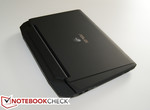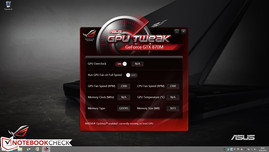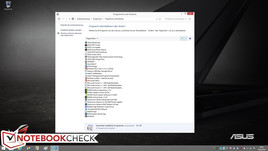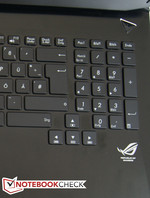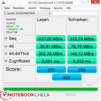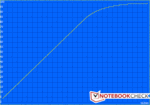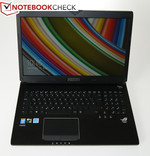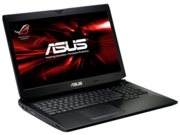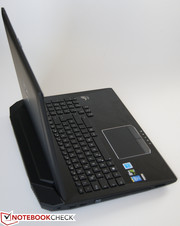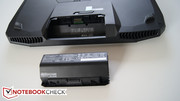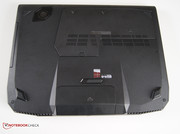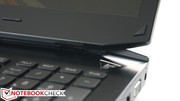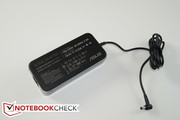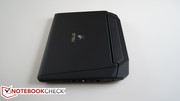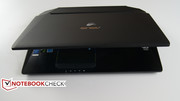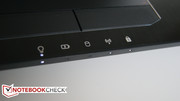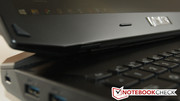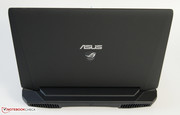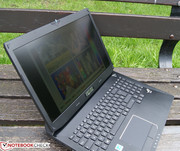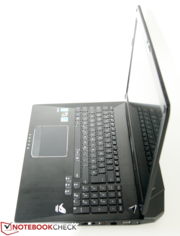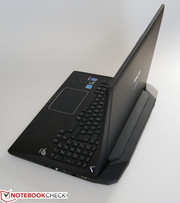Asus G750JS-T4064H Gaming Notebook Review

For the original German review, see here.
The Republic of Gamers branding has always stood for the premium range of Asus' gaming laptops, and every generation achieved impressive scores so that the gamer not only visually immerses in the World of Games, but also experiences the entire gaming atmosphere via the 2.1 sound system.
A 17.3-inch Full HD screen and a bundle that was designed for gaming contributes to this gaming experience. Asus now also endeavors to introduce the new Nvidia GTX 800 series, and installs the GTX 870M in our case. We introduced the new G750 range that stands out with its striking features in July 2013.
The line, dubbed Elite Series by Asus, now consistently sports an Intel Core i7-4700HQ CPU. The buyer can opt between the GTX 860M, 870M or 880M among other things and this explains the big price differences. The 860M version starts at 1400 Euros (~$1912), the 870M model that we are testing costs 400 Euros (~$546) more, and finally the top model with the GTX 880M for 2000 Euros (~$2731).
First, we would like to look at the comparison models, which represent either direct or indirect competition. Among them is One's K73-4N, also with a GTX 870M but a higher clocked Intel Core i7-4800MQ processor. One's K73-4N undercuts the purchase price of Asus' device by almost 150 Euros (~$205) at 1660 Euros (~$2267). Another player is MSI's GT70 that features an Nvidia GTX 880M and Intel Core i7-4800MQ for 50 Euros (~$68) more. To complete the team, we will use the superlative of gaming in the form of Schenker's XMG P704 that sports an Nvidia GTX 880M like MSI's machine, but which sports the high-end Intel Core i7-4910MQ. Sold for a significantly higher purchase price of 2800 Euros (~$3824), we will analyze whether the additional 1000 Euros (~$1366) is justified and to what extent it can keep up with the G750JS or whether it even outperforms it.
Case
The unusual build and a matte, rubber-coated plastic casing have impressed us ever since the G46 product line. The design featuring sharp edges already suggests the power of Asus' G750JS. Although the laptop is anything but a lightweight, weighing 4 kg (~8.8 lbs), it is 700 grams (~1.5 lbs) lighter and 8 mm (~0.3 in) thinner than the model sporting Nvidia's GTX 880M. In contrast, MSI's GT70 is 5 cm (~2 in) thicker and 300 grams (~0.66 lbs) lighter than Asus' G750JS, but does not use visible gimmicks.
When opened, the user finds a brushed aluminum plate around the keyboard. Both sides of the work area slope off in a trapeze shape. The chrome-ringed trackpad and ROG logo adorn the keyboard area. The looks of both the closed and opened device in conjunction with the materials and edges already suggest what is inside. The rubber coating is a poor choice in terms of cleanliness. It attracts dust and the brushed plate exhibits every fingerprint.
The plastic underside allows accessing the hard drive and working memory after removing one screw. All screws are tastefully protected by rubber caps that can be removed easily. The battery, that looks small in contrast to the other laptops, can be released or replaced by the familiar slider. Overall, the Asus G750JS not only feels good, it also conveys a good quality impression. The dimensions and weight do not give the laptop a bulky appearance, but lets it look powerful and menacing. Furthermore, Asus has eliminated the crooked hinge of our Asus G750JW review sample, and the new laptop from the G750 line makes an impeccable esthetic impression. The only adverse things are that the display is a bit too loose, which is noticed when the laptop is turned around, and the countless rubber stoppers on the display's bezel.
Connectivity
No modifications have been made in port distribution or number of interfaces since the release of the new G750 line. All ports are on either the left or right because the vents and the battery do not allow a placement on the laptop's rear. The only thing new is that a Blu-ray drive rather than a DVD drive is now installed. The audio ports on the right are a matter of taste as they occasionally proved to be interfering. The incorporated Thunderbolt port can prepare Asus' G750JS for the future by making it possible to use external graphics cards and replace all kinds of missing ports. Unfortunately, Thunderbolt adapters are usually very pricey. In sum, the laptop features more than an adequate count of ports that have, by and large, been placed in the right position.
Communication
An important innovation is the new "Bigfoot Networks Killer Wireless 1202" Wi-Fi adapter. It was questioned whether the Broadcom 802.11ac would still be used for the product line in the old test. Rather than a transmission rate of 876 Mbit/s like in the former model, the new Wi-Fi adapter "only" promises 300 Mbit, but also "Advanced Stream Detection". That means that the driver has specifically been developed for gaming and streaming purposes. Technically, the drivers are programmed so that games and streaming services have a higher priority and that they receive more time on the communication module via priority waiting lines.
Accessories
There are no noteworthy accessories included for Asus' G750JS. A Velcro cable tie, a few ROG stickers, a microfiber cloth, and diverse printed documents are found. Optional ROG accessories, such as a mouse or headset, can be ordered on the manufacturer's website. Regrettably, there are no accessories specifically developed for the G750 line.
Maintenance
As mentioned above, it is very easy to access the working memory modules and hard drives by removing their plastic cover. The entire base plate has to be taken off for more far-reaching maintenance, which is tedious. In view of the big vents, it would be expected that cleaning the fans would at least be simple, but the entire laptop has to be disassembled for that. More information can be found in the review of the precursor.
Warranty
Asus includes the well-known two-year pick up & return manufacturer's warranty and telephone support. Like most major manufacturers, optional warranty extensions and insurances can be added for a surcharge. The large ROG community can be asked in case of questions or problems. News about this series is posted in a blog in its own forum, and users can help each other.
Input Devices
Keyboard
The modified chiclet keyboard (37 x 10.5 - 12.2 cm; ~14.6 x 4.1 to 4.8 inches) of the G750 line convinces with a very good pressure point and a three-level backlight. The number pad and the keyboard are separated by 9 mm spacing. The arrow keys are centered just below this gap. The inconsistent spacing and the positioning of the neighboring keys needs some familiarization when using the arrow keys and keyboard at the same time.
Both the feedback and typing feel are subjectively pleasing and the restrained stroke noise is more than just acceptable. The keyboard is the perfect tool for gaming owing to the standard-sized arrow keys and accurate pressure point.
Like before, the only complaint is that Asus does not incorporate additional keys instead of FN combos, or hot keys for gaming - there is enough room for that.
Touchpad
A big laptop calls for a big touchpad - at least that might come to mind when looking at Asus' G750SJ. The size of 11.7 x 6.6 cm (~4.6 x 2.6 in) is gigantic compared with MSI's GT70 and One's K73-4N. It also pleases with accurate and smooth gestures.
Gesture control for up to three fingers can be configured via the included Asus Smart Gesture software. Scrolling, zooming, and rotating are only a few of the settings that we not only like, but also function smoothly and accurately. A fourth finger is detected, but there are no optional settings for it. An important yet not always available setting is disabling the touchpad when an external mouse is used. This is easily accomplished via the included tool in this case. Both dedicated mouse keys feature a soft and even pressure point with an agreeable feedback.
Touchpads normally cannot replace an external mouse, but the term "replacement" is more than justified. The functional total bundle of the new G750SJ is decent, and the additional, elegant chrome looks of the ring separate it from the rest of the keyboard unit. We were disappointed to find the accuracy in the pad's corners is not maintained or even completely vanishes.
Display
What function does the screen have in a gaming and desktop replacement system? It is the interface between hardware and user, and presents all the performance and beauty of the application. That is exactly the reason why the standards should be set high here. Inferior screens often simply restrict the game's playing worthiness.
The AUO Full HD screen's average brightness of 273 cd/m² lags far behind the rates of the former G750 line and behind its contenders, which can "shine" with an average brightness of over 330 cd/m². It can be said that Asus has taken a step in the wrong direction at this point and should again achieve rates like in the former G750 line. To improve in all respects, Asus should use an IPS screen in its pricey high-performance machines.
| |||||||||||||||||||||||||
Brightness Distribution: 88 %
Center on Battery: 276 cd/m²
Contrast: 575:1 (Black: 0.48 cd/m²)
ΔE ColorChecker Calman: 8.24 | ∀{0.5-29.43 Ø4.78}
ΔE Greyscale Calman: 8.83 | ∀{0.09-98 Ø5}
59% AdobeRGB 1998 (Argyll 1.6.3 3D)
65.9% AdobeRGB 1998 (Argyll 3D)
90.1% sRGB (Argyll 3D)
68.6% Display P3 (Argyll 3D)
Gamma: 2.51
CCT: 10215 K
Although the contrast of 575:1 shows some improvement, all comparison devices have an outstanding contrast of 1000:1, which is a difference of approximately 75%. The combination of brightness and contrast lead to a black level of 0.48 cd/m², which is acceptable and renders a decent black in movies and gloomier games.
We recorded a good result of 80% that can compete with all contenders in the sRGB color space coverage. Asus' G750JS achieved a coverage of 59% in the AdobeRGB color space assessment. These are normal rates for a higher-quality TN screen, but not sufficient for professional use.
We have discovered a typical pattern in the analysis of the color reproduction. A clear bluish cast is visible in the state of delivery when looking closer, which was already common for the screens in the former models. This phenomenon is not noticeable or even distracting in "normal" application fields, but TN screens should not be used in the professional field due to the just mentioned color space coverage.
We examined the DeltaE shift in the color accuracy analysis and received middling rates of just over 8 in both colors and grayscale. Better CalMAN results were achieved by the Asus G750JZ, which sports an Nvidia GTX 880M, because Asus installs its own color profile only in this model.
Barely anyone will want to use the over four kilogram (~8.8 lbs) laptop outdoors, although matte screens are designed for potential outdoor use. However, the screen looks quite dark due to the comparatively low brightness, and should not be used in direct sunlight. It is possible to work quite well and without annoying reflections in slightly shadier places using maximum brightness.
It soon becomes evident that colors and brightness deviate when looking at the screen from the sides. Asus touts a viewing angle stability of 140 degrees, which we can only confirm to an extent here. We could verify this stability in the former G750 models, and only discovered deviations in different tilt angles. Though it will not impair the lone user, we ascertained visible color and brightness differences in the sofa test, i.e. the laptop is on a table and a group of friends intends to watch videos or the like on the laptop.
Performance
Power - that is what Asus' G750JS has been made for and it can excel with premium range components. It sports an Intel Core i7-4700HQ that clocks with 2.4 GHz, which can vary between 3.2 GHz in Turbo Boost mode and 800 MHz in energy-saving mode in quad-core operation. MSI's GT70 and One's K73-4N both sport the i7-4800MQ that has a higher Boost, and consequently, also achieves a higher level despite the same cache and identical base clock.
Despite the fact that the G750JS features premium range components, Asus could have certainly upgraded the CPU to an i7-4800MQ / 4900MQ in view of the price of 1800 Euros (~$2459). They have more cache and/or a higher clock with the same TDP.
Processor
As a high-performance laptop CPU, Intel's Core i7-4700HQ is usually found in larger 15 or 17-inch models. Since the integrated Intel HD 4600 graphics card is active, switching between the dedicated and internal graphics cards is possible. That spares both the battery and electricity bills. Intel's Core i7-4700HQ has a base clock of 2.7 GHz and features a Turbo mode that enables a short performance boost. Thus, a Turbo speed of up to 3.4 GHz can be reached in single-core mode, i.e. when only one of the four cores is loaded. That is 200 MHz more than the possible 3.2 GHz in multi-core operation.
Asus' laptop is defeated by all contenders in Cinebench R15 because they sport Intel's Core i7-4800MQ and thus have a higher boost and can thus achieve higher performance. Despite that, with a score of 641 points the CPU performs well in multi-core operation, which does not change in battery mode.
We did not notice any unusual performance deficits in other respects and did not ascertain throttling either.
| Cinebench R15 - CPU Multi 64Bit (sort by value) | |
| Asus G750JS-T4064H | |
| One K73-4N | |
| MSI GT70 2PE-890US | |
| Schenker XMG P704 | |
| Cinebench R15 - CPU Single 64Bit (sort by value) | |
| Asus G750JS-T4064H | |
| One K73-4N | |
| MSI GT70 2PE-890US | |
| Schenker XMG P704 | |
System Performance
Asus' G750JS is a perfect combination of SSD hard drive, premium range graphics card and CPU. It always makes a swift and ready-to-go impression subjectively.
The PCMark 7 score of 5348 points confirms our feeling because this score is considerably higher than that of MSI's GT70 with its magnetic hard drive and which achieved a lower total score of 3566 points. The laptop with the most similar hardware seems to be One's K73-4N that sports a slightly modified CPU. That is also the reason why One's device reaps in 700 points more than Asus' G750JS.
| PCMark 7 Score | 5348 points | |
| PCMark 8 Home Score Accelerated v2 | 3195 points | |
| PCMark 8 Creative Score Accelerated v2 | 4775 points | |
| PCMark 8 Work Score Accelerated v2 | 4199 points | |
Help | ||
Storage Devices
As mentioned, Asus' G750JS sports two hard drives, one of which is an SSD that is divided into two partitions ex-factory. The SSD has a 100 GB system drive and a 120 GB data drive. The magnetic drive is split up equally. This combination enables short access times and enough storage for all kinds of data at the same time. The 1.5 TB HDD's access time of over 16 ms can in no way be put in relation to the SSD's rates.
Like the G750JS, both One's K73-4N and Schenker's XMG P704 also sport SSD drives. Both achieved an approximately 70MB/s higher speed in the sequential read/write test.
Graphics Card
Nvidia's GeForce GTX 870M is a premium range graphics card based on Nvidia's Kepler architecture. It has 3 GB of dedicated memory and Asus overclocks the core clock to 981 - 1000 MHz rather than 941 - 967 MHz in our case. Nvidia's Optimus switches between both graphics units imperceptibly for the user. We tested the graphics card's overclocking with 3DMark 11 and the difference between both scores was not even 3%. Thus, Nvidia's GTX 870M score of 7151 points is approximately 185 points more than without overclocking.
A look at One's K73-4N shows that both laptops achieve similar rates in 3DMark Vantage and 3DMark 11, although the Asus GPU overclocks. Nevertheless, a terrific score of 24,000 points is achieved in 3DMark Vantage, which surpass Nvidia's GTX 870M precursor, i.e. the GTX 770M, by approximately 26%. The difference of approximately 38% in 3DMark 11 is even more striking.
Asus' laptop cannot compete with the stronger Nvidia GTX 880M that is installed in both MSI's GT70 and Schenker's XMG P704. MSI's machine achieves a 1000 point higher score in 3DMark 11 and 4000 points in 3DMark Vantage.
The dedicated graphics card cannot and should not be used in battery mode for a long period due to its high power consumption. However, it is possible to use it without a great performance loss according to our tests. The scores achieved in battery mode in both 3DMark 06 and 3DMark 11 were within the normal variance of results.
| 3DMark 06 Standard Score | 25112 points | |
| 3DMark Vantage P Result | 23833 points | |
| 3DMark 11 Performance | 7151 points | |
| 3DMark Fire Strike Score | 4384 points | |
Help | ||
| 3DMark 11 - 1280x720 Performance (sort by value) | |
| Asus G750JS-T4064H | |
| One K73-4N | |
| MSI GT70 2PE-890US | |
| Schenker XMG P704 | |
Gaming Performance
Now for the test that laptops like Asus' G750JS were made for - gaming. Most games should not be a big problem with Nvidia's GTX 870M. We will see where compromises have to be made based on our benchmark scores and compare the contenders with Nvidia's GTX 880 at the same time.
A difference between both graphics card models is already evident in the game FarCry 3. While FarCry 3 is just still fairly playable with an average of 27.7 fps on Asus' laptop, Nvidia's GTX 880M in Schenker's XMG P704 allows a considerably smoother gameplay with almost 36 fps.
These few frames per second often decide whether the user can immerse into a game or if he will be annoyed by recurrent minor stutters. Grid 2 and FIFA 14 rendered so many frames that a faster graphics card does not make a visible difference. The result of the performance-devouring game Company of Heroes is interesting. The GTX 880 in MSI's GT70 only managed 24.1 fps, which is 2 fps more than the GTX 870M. Generally, the rates that Asus' laptop achieves are in the midfield of the laptops featuring Nvidia's GTX 870M. Our section about the gaming performance of laptop graphics cards provides a larger selection of games and comparison rates also for Nvidia's GTX 870M.
| low | med. | high | ultra | |
|---|---|---|---|---|
| Far Cry 3 (2012) | 104.2 | 88.4 | 67.7 | 27.7 |
| Metro: Last Light (2013) | 85 | 80.3 | 61.9 | 35.3 |
| GRID 2 (2013) | 137 | 102 | 69.5 | 63.6 |
| Company of Heroes 2 (2013) | 55.3 | 51.4 | 44.8 | 22 |
| Total War: Rome II (2013) | 217.5 | 161.2 | 129.5 | 31.6 |
| Fifa 14 (2013) | 330.5 | 248.7 | 235.5 | 181.1 |
| Assassin´s Creed IV: Black Flag (2013) | 59.6 | 58.5 | 53.5 | 31.1 |
| Asus G750JS-T4064H GeForce GTX 870M, 4700HQ, SanDisk SD5SE2256G1002E | One K73-4N GeForce GTX 870M, 4800MQ, Samsung SSD 840 EVO 500GB | MSI GT70 2PE-890US GeForce GTX 880M, 4800MQ, HGST Travelstar 7K1000 HTS721010A9E630 | Schenker XMG P704 GeForce GTX 880M, 4910MQ, Crucial M500 480 GB CT480M500SSD3 mSATA | |
|---|---|---|---|---|
| Far Cry 3 | 4% | 25% | ||
| 1366x768 DX11 High Preset (SSAO, Standard Alpha To Coverage) AA:2x MS (fps) | 67.7 | 70.7 4% | 81.8 21% | |
| 1920x1080 DX11 Ultra Preset (HDAO, Enhanced Alpha To Coverage) AA:4x MS (fps) | 27.7 | 28.4 3% | 35.7 29% | |
| Metro: Last Light | -2% | 22% | 21% | |
| 1366x768 High (DX11) AF:16x (fps) | 61.9 | 61.4 -1% | 75.9 23% | 75.2 21% |
| 1920x1080 Very High (DX11) AF:16x (fps) | 35.3 | 34.4 -3% | 42.4 20% | 42.6 21% |
| GRID 2 | ||||
| 1920x1080 Ultra Preset AA:4xMS (fps) | 63.6 | 64.1 1% | 72.6 14% | 76.2 20% |
| Fifa 14 | ||||
| 1920x1080 High Preset AA:4x MS (fps) | 181.1 | 294 62% | ||
| Company of Heroes 2 | 8% | |||
| 1366x768 High AA:Medium (fps) | 44.8 | 46 3% | ||
| 1920x1080 Maximum / Higher / High AA:High (fps) | 22 | 24.7 12% | ||
| Assassin´s Creed IV: Black Flag | 10% | |||
| 1366x768 High / On / SSAO (PhysX Off) AA:2x MS (fps) | 53.5 | 57 7% | ||
| 1920x1080 (Very) High / On / HBAO+ (PhysX off) AA:4x MS (fps) | 31.1 | 35 13% | ||
| Total Average (Program / Settings) | 1% /
1% | 23% /
19% | 22% /
22% |
Emissions
System Noise
As known from the Elite Series, the produced noise level is pleasantly quiet. However, a minor drawback of this line is the slight but barely audible whistling noise when idle. Disregarding this peculiarity, the average idle noise is 31 dB(A), which is 3 - 4 dB(A) lower than the contenders.
The drive's additional high noise level when rendering DVDs and Blu-rays can be distracting. However, it is only perceived as a quiet buzzing with 38.2 dB(A) here and consequently does not seem annoying.
Load operation is naturally interesting because it is the most important scenario for a laptop with outstanding performance. Asus' G750JS achieves an average noise of 41.3 dB(A). That is far below its contenders even with a maximum of 50.4 dB(A). One's K73-4N with a similar configuration is clearly above Asus' laptop with an average of 49 dB(A) and maximum of 52.3 dB(A).
Noise level
| Idle |
| 29.2 / 31 / 32.6 dB(A) |
| HDD |
| 30.8 dB(A) |
| DVD |
| 38.2 / dB(A) |
| Load |
| 41.3 / 50.4 dB(A) |
 | ||
30 dB silent 40 dB(A) audible 50 dB(A) loud |
||
min: | ||
Temperature
The G750 product line is known for its good circulation and waste heat dissipation via its dual system fans. The temperature development in the keyboard area and on the laptop's underside were noticed. We performed the tests in an ambient temperature of 24 °C (75.2 °F). Asus' laptop did not surpass 30 °C (86 °F) when idle and only reached a temperature of over 29 °C (84.2 °F) on the underside. Its contenders achieve similar rates and only Schenker's XMG P704 noticeably steps out of line with 33.5 degrees.
Load operation shows just how well the cooling system really works and we recorded a temperature of over 40 degrees (104 °F) only twice. In particular, the keyboard side never exceeded 35 °C (95 °F), which is very pleasant and will not adversely affect typing.
The thighs never got too hot in our renowned on-the-lap test. However, users should think twice whether they want to use an over four kilogram (~8.8 lbs) heavy machine that way.
The power supply's temperature ranged from 32.3 °C (90.14 °F) when idle and a hot 51.4 °C (124.52 °F) during load, and thus should not be covered by a pillow or blankets.
A peculiarity is seen in the stress test. Asus' laptop does not throttle despite maximum performance and can even sometimes maintain its Turbo. A consequence could be that some games will run a bit smoother than on other laptops under full load.
We did not observe any losses when we repeated the benchmarks after an hour of stress testing. The well-designed cooling system by Asus provided a truly outstanding result.
(+) The maximum temperature on the upper side is 34.8 °C / 95 F, compared to the average of 40.4 °C / 105 F, ranging from 21.2 to 68.8 °C for the class Gaming.
(±) The bottom heats up to a maximum of 42.3 °C / 108 F, compared to the average of 43.3 °C / 110 F
(+) In idle usage, the average temperature for the upper side is 27.6 °C / 82 F, compared to the device average of 33.9 °C / 93 F.
(+) The palmrests and touchpad are cooler than skin temperature with a maximum of 27 °C / 80.6 F and are therefore cool to the touch.
(±) The average temperature of the palmrest area of similar devices was 28.9 °C / 84 F (+1.9 °C / 3.4 F).
Speakers
The speakers installed below the display and the subwoofer, with a diameter of 3 cm (~1.2 in) on the underside, are more than sufficient for normal home use. In particular, the volume can be turned up extremely high, and the bass produced by the subwoofer is acceptable for a laptop. The default configuration ex-factory could be criticized. It delivers a bit too much treble and will have to be adjusted. Overall, the 2.1 sound system provides a good sound that is not heard from many laptops.
Energy Management
Power Consumption
The low minimum idle power consumption of 11 Watts will be seen in the battery runtime. The brightness is set to minimum and communication modules like Wi-Fi are off. The identically equipped One K73-4N consumes almost 4 Watts more and Schenker's XMG P704, which counts as the ultimate high-performance machine in this test, reaches a quite high 20 Watts. Not more than 23.8 Watts are consumed even using Wi-Fi and maximum brightness, which is 5 - 10 Watts less than the comparison devices.
The dedicated graphics card is enabled during load. It has a significantly higher consumption and demands 181.2 Watts from the power supply in the stress test. That is very close to the power supply's limits in view of a voltage of 19.5 V and 9.23 A. The maximum power consumption is lower than the 196 Watts from One's K73-4N, but it also comes with a strong 230 W power supply. The results are fortunately around 100 Watts outside the stress test, which the power supply easily manages.
| Off / Standby | |
| Idle | |
| Load |
|
Key:
min: | |
Battery Runtime
The battery runtime of high-performance machines is usually short due to the power consumption of the premium components. This fact can also be translated to the battery's size that suggests a short battery runtime at first glance. However, we achieved a remarkable idle runtime of over 10 hours that is in no way typical for this laptop category. One's K73-4N and Schenker's XMG P704 managed a runtime of 3 - 4 hours, and MSI's GT70 achieved a better yet not competitive time of 6.5 hours.
Asus' laptop still achieved a good time of almost 5.5 hours in the Wi-Fi test. MSI's GT70 tops that by an hour. Power is demanded from the laptop in the load test and consequently not only higher clock rates, but also switching to Nvidia's dedicated GPU is the reason why the runtime drops to 1:28 h.
Overall, Asus' laptop achieved astonishing results that could considerably influence the purchase decision. Apart from the awesome runtime for this laptop category, we also like the easy-to-replace battery.
A supplementary and interesting fact is that the battery needs 162 minutes for recharging.
Verdict
Asus' G750JS rightly carries the Republic of Gamers logo and, like former models, convinces with a high quality standard and performance. The buyer gets a solidly built and robust laptop for 1800 Euros (~$2459) that allows mobile use even without the power supply owing to the remarkable battery runtime and the large, user-friendly touchpad. Should the subcategories of a gaming laptop not be important, and particular focus is placed on performance, the equally priced competition like MSI's GT70 with Nvidia's GTX 880M is certainly an alternative.
Remarkable and rarely seen are also the quiet fans, and the maximum Turbo Boost clock despite permanent stress test load.
However, the inferior screen will likely be an annoyance, especially since it is very viewing angle unstable when tilted, and has a considerably lower brightness than the contenders. Asus should at least offer a higher-quality IPS screen as an option.





